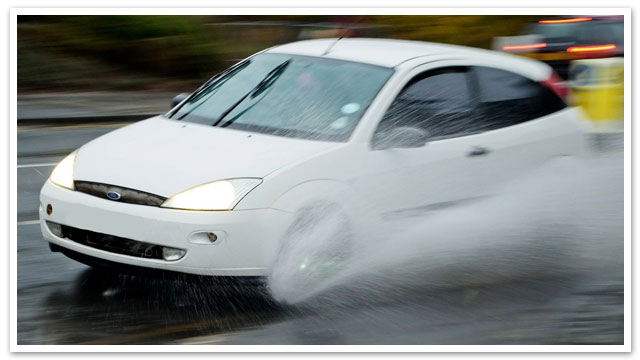Hydroplaning
Water on the roadway is dangerous because it can cause hydroplaning. Hydroplaning is when your vehicle’s tires lose contact with the pavement because of water and consequently, you lose control of the vehicle. Be aware that hydroplaning can occur even when you’re driving in small amounts of water at a slow speed.
Average-sized cars begin to hydroplane at 35 to 40 miles per hour, and smaller cars can hydroplane at lower speeds. Heavier vehicles will hydroplane at faster speeds. The faster you are traveling when you hit water, the more dangerous the hydroplaning will be. Sometimes a vehicle will fishtail, swerve or spin. Hydroplaning is affected by the size and weight of the car and the condition of your tires.
What is Hydroplaning?
 Hydroplaning
Hydroplaning
What to Do When Your Car Hydroplanes
Most drivers realize they're hydroplaning when they try to brake or change directions but are unable to do so. You may feel like your vehicle is sliding. Hydroplaning can happen in an instant, and your vehicle is often able to regain traction just as quickly. If your vehicle starts to hydroplane, do not:
- Panic
- Slam on the brakes
- Try to make a sudden turn
Instead, take your foot off the brake. Our instinct tends to be slamming on the brakes when something goes wrong on the road, but that will just cause your car to skid. If you're using cruise control, disengage it. Try not to use cruise control at all on wet roads as you'll likely reduce your speed more frequently to stay safe.
If your car is spinning, gently turn your wheel in the direction you want your vehicle to go. You can apply light pressure to the brakes, but don't press down or "pump" them unless your vehicle doesn't have anti-lock brakes. Do not turn jerk your steering wheel in one direction or the other (i.e., overcorrecting). Move your wheel gradually and keep your hands steady.
You'll be able to feel when your tires make contact with the surface of the road again. Once you've regained control of your vehicle, continue to drive cautiously. If you're experiencing anxiety or panic, you may need to pull over in a safe place and take some deep breaths to regain composure. It's not safe to drive when your emotions are high.
How to Prevent Hydroplaning
There are a few things you can do to help prevent hydroplaning. First, reduce your speed on wet roads. The most dangerous time to drive on wet roads is just after the rain starts. This is because water mixes with oil and debris on the road, making you more likely to hydroplane. Once it's been raining for a while, the road is cleaner and potentially a little safer, but always use caution when driving in the rain and on wet roads.
Next, make sure your tires are in tip-top condition. Check out our guide to taking care of your tires here. Tires that are underinflated or have low tread lose traction easily and are more likely to hydroplane than tires that are in good condition.
Finally, always keep plenty of space between your vehicle and the one in front of you. If either of you begin to hydroplane, you'll need plenty of space to recover. There should be enough room in front of you that you won't have to slam down on the brakes if the car ahead of you slows down or hydroplanes. Instead, you'll be able to come to a gradual stop and decrease your own chances of hydroplaning and skidding.